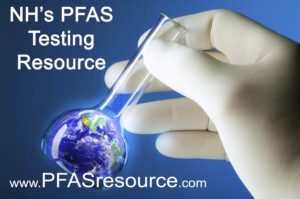PFAS Method 533 at ARA
 ARA is nailing down the final certification details as we add EPA Method 533 for PFAS to our lab offerings. Method 533 was released by EPA in December of 2019 for the determination of Per and Polyfluoroalkyl Substances (PFAS) in drinking water by Isotope Dilution Anion Exchange Solid Phase Extraction & Liquid Chromatography / Tandem Mass Spectrometry.
ARA is nailing down the final certification details as we add EPA Method 533 for PFAS to our lab offerings. Method 533 was released by EPA in December of 2019 for the determination of Per and Polyfluoroalkyl Substances (PFAS) in drinking water by Isotope Dilution Anion Exchange Solid Phase Extraction & Liquid Chromatography / Tandem Mass Spectrometry.
ARA is currently certified for EPA Method 537.1 and LC-MS/MS using quantitation by isotope dilution. EPA Method 533 should be online at ARA in Q2 of 2021.
We are proud to be able to say that ARA is the only PFAS Certified Lab located in NH.
 The benefits of analyzing your PFAS samples in house are many, including:
The benefits of analyzing your PFAS samples in house are many, including:
- lower costs
- shorter turnaround times
- better communication
- access to the chemists running your samples
- excellent customer service and
- keeping NH business in NH!
(This last one is a big draw for our customers.)
FYI, lower PFAS MCLs became effective in October 2020 for public water systems in NH. If you need to test for the 4 regulated compounds in NH, or have questions about pricing, limits, compound lists, etc., give ARA a call or send an email.
New Arsenic Limits Effective July 1st
The maximum contaminant level (MCL) for arsenic in drinking water is being lowered in NH, going from the federal standard of 10 micrograms per liter (ug/L) or parts per billion (ppb), to 5 ppb.
While the EPA limit is still in effect for most of the US, New Hampshire has implemented the lower MCL, based on the most recent information on health effects and treatment costs. This new limit for arsenic goes into effect on July 1, 2021.
 According to Borsuk et al. 2014, roughly 30% of NH wells have elevated levels of arsenic (>5 ppb). Since you cannot see, smell, or taste arsenic in water, the only way to find out if water is safe to drink is to have it tested by a certified laboratory. Consuming water that contains arsenic has been associated with an increased risk of diabetes, cardiovascular issues, skin lesions, certain cancers, and lowered IQ in children.
According to Borsuk et al. 2014, roughly 30% of NH wells have elevated levels of arsenic (>5 ppb). Since you cannot see, smell, or taste arsenic in water, the only way to find out if water is safe to drink is to have it tested by a certified laboratory. Consuming water that contains arsenic has been associated with an increased risk of diabetes, cardiovascular issues, skin lesions, certain cancers, and lowered IQ in children.
If you received notification from NHDES that you need to perform quarterly monitoring for arsenic, or you would like to test your own drinking water for arsenic, let us know!
Click to View the Updated (2020) NHDES Arsenic Fact Sheet
PFAS Study at Pease Seeking Participants
Did you consume water at Pease Tradeport between 2004 and 2014? The CDC is seeking volunteers for their health study on PFAS. This short video shows what participants can expect when they join the study. Participants may be eligible for up to $75 in Gift Cards from CDC.
The Agency for Toxic Substances and Disease Registry (ATSDR) and the Centers for Disease Control and Prevention (CDC) are asking families who worked or went to school/ daycare at Pease Tradeport in NH between 2004 and 2014 to join their health study related to PFAS exposure. There are seven similar studies at PFAS-contaminated sites around the country. Organizers of the Pease study are hoping to recruit 1000 adults and 350 children who may have consumed water at Pease during that time period, but are only halfway to their goal.
If you know anyone who might fit the criteria for this study, you can read more about it and how to get involved here: https://www.atsdr.cdc.gov/pfas/activities/pease.html
Avoid Demo Day Surprises: 5 Tips to Keep Your Reno/Demo on Track
 Spring is in the air and construction projects are ramping up big time. But before swinging the sledgehammers and opening a big messy can of worms, make sure you have gone over a Pre Demo Safety Checklist. Asbestos, Lead, Black Mold and other environmental hazards can be lurking just out of sight, and human exposure can be very dangerous. Know the laws, know what to look for, and when in doubt, ask! Your Town Hall, State’s Department of Environmental Services, EPA, and firms like ARA are great places to get answers ahead of time so you don’t put anyone at risk or run into big problems down the road.
Spring is in the air and construction projects are ramping up big time. But before swinging the sledgehammers and opening a big messy can of worms, make sure you have gone over a Pre Demo Safety Checklist. Asbestos, Lead, Black Mold and other environmental hazards can be lurking just out of sight, and human exposure can be very dangerous. Know the laws, know what to look for, and when in doubt, ask! Your Town Hall, State’s Department of Environmental Services, EPA, and firms like ARA are great places to get answers ahead of time so you don’t put anyone at risk or run into big problems down the road.
Here are a few important reminders for Municipalities issuing permits, Contractors, Building Owners, and Weekend Warriors:
- A Hazardous Materials Survey performed by a certified inspector will provide you with the required legal documentation related to the presence / absence of lead, asbestos, PCBs and any other regulated hazardous materials on site.
- Any structure built before 1978 is very likely to contain both lead paint and asbestos.
- Building owners / contractors are required to have a certified asbestos inspection prior to renovation or demolition.
- If asbestos is identified, it should only be removed by a Licensed Asbestos Abatement Contractor.
- Homes and buildings that may be occupied by children are subject to Federal Lead Laws
Homeowners doing their own renovations are strongly urged to understand potential hazards (especially asbestos and lead paint) and follow best practices to keep everyone safe. No time, no budget? We hear that a lot, and we get it. But ignoring these issues and the potential health risks, combined with possible EPA/OSHA violations, could be devastating. Questions/concerns? Give us a call; we can help keep your project (safely) on track.
 ARA Wins National Award from Environmental Business Journal
ARA Wins National Award from Environmental Business Journal
Environmental Business Journal® (EBJ), an international research publication providing strategic business intelligence to the environmental industry has honored Absolute Resource Associates (ARA) of Portsmouth, NH with an EBJ Business Achievement Award for Project Merit. To view the full press release click here.
The Resource Rambler Newsletter is brought to you by your friends at Absolute Resource Associates ©


